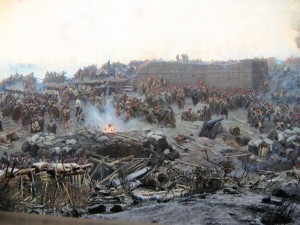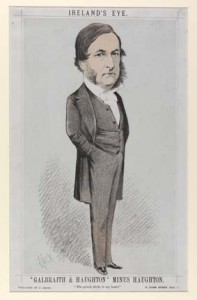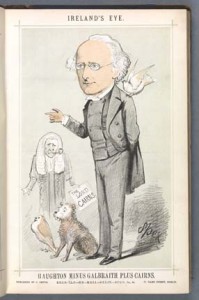Patriotism, pedagogy and profit: Galbraith and Haughton’s Mathematical Series (1851–91)
Published in 18th-19th Century Social Perspectives, Features, Issue 2 (March/April 2015), Volume 23
Detail from Franz Roubaud’s panoramic painting The Siege of Sevastopol (1904). Such was the level of incompetence displayed by British Army officers in the Crimean War (1854–6) that parliament consequently abolished access to military commissions by privilege and replaced it with public examination.
Intended market
The intended market for the Mathematical Series was students preparing for entry into the ICS and Artillery School registering in the courses offered by the authors at TCD, but other TCD teachers adopted them too. Up to 1923, physics students in Trinity had to read Optics, and the Engineering School (founded in 1842), where G&H were examiners, used the manuals, processing 150 applicants per year.
Private institutions where the G&H manuals were used sprang up near Trinity: the School for Collegiate and General Education, 6 Hume Street; the Collegiate, Nautical and Mercantile Institute, 80 Middle Abbey Street; the General Educational and Collegiate Institute, 4–5 Ormond Terrace, Rathmines; and Mr De Burgh’s Establishment, which provided direct access to Woolwich and Sandhurst, 6 Harcourt Street. G&H were also examiners at the Royal Hibernian Military School. There were similar institutions outside Dublin, such as the Royal School at Portora, Enniskillen, Co. Fermanagh.
Required reading by other professions
Professions requiring some level of numeracy found the manuals useful. In Ireland, prospective barristers were expected to study Arithmetic, which was also on the reading list for the Law Society, and Algebra was advertised in The Irish Jurist. Schools of medicine at home and abroad required knowledge of the Mathematical Series as a standard. The British Medical Journal, commenting on the requirements for entry into the school of medicine in St Andrews, Scotland, said:
‘The following are the subjects (for the registration exam); Mathematics: elementary rules of arithmetic, Euclid books I and II, Algebra as far as simple equations, Elements of mechanics . . . (A thorough knowledge of the manuals on these subjects by Haughton and Galbraith will enable candidates to pass this portion of the examination.)’
One or more of the manuals were recommended reading for entry in Otago, in Belfast and Maynooth and in the Universities of London, McGill (1863–93) and Melbourne. James Clerk Maxwell, professor in Aberdeen, recommended Optics, Hydrostatics and Mechanics. In Elphinstone College in Bombay, India, the Mathematical Series was translated into Urdu and adopted with success.
Schools
Perhaps the greatest market was the school system. In 1857 the manuals were placed on the ‘list of school books recommended by the education committee of the privy council’, but G&H were their own best salesmen. In a report they delivered to the House of Commons on the performance of the public examination system in April 1858, they said:
‘[Our military class in TCD] . . . has given the strongest possible proof of the stimulus which the competitive system has given to education . . . The best men in the class are those who have just entered College, fresh from school. Certain schoolmasters in Ireland, to whom we addressed circulars on this subject in 1855, established classes in their schools . . .’
Mathematical Tables was still standard issue in some schools in England in the 1920s. The Monthly Paper of the National Society for promoting the Education of the Poor in the provinces of the Established Church in England and Wales also listed the manuals.Measuring success
The Civil Service Commissioners, in their annual reports to the House of Commons, established that from 1805 to the end of the patronage system in 1855 the East India Company appointed 426 young men for training at Haileybury College, or 10.6 per year, of whom a total of twenty were Irish. This is approximately one Irish person appointed every two years. From 1855 to 1874 there were 159 Irishmen admitted, and from 1874 to 1905 the average yearly intake was 44.1 students, varying from only twelve in 1858 to 82 in 1862.
The second open examination for entry to the services was to fill twenty vacancies. Four of these were obtained by Irish students, three presented by TCD. The Trinity-trained students obtained the fourth, seventh and tenth places. The remaining Irish student came from Queen’s College, Cork. Cambridge had obtained five placements, including the first, and Oxford had obtained four, who ranked tenth, eleventh, sixteenth and nineteenth in the overall list. Second and third places were taken by the only two candidates from London University. The reporter continues:
‘The success of the Dublin University pupils is mainly owing to exertions of two gentlemen . . . the Rev. Mr Galbraith and the Rev. Mr Haughton . . . These gentlemen . . . have trained their classes, not only in the scientific department, but they also take care that their aptitudes in other branches of knowledge are carefully developed. Not only do they attend to them during the preparatory course, but they take charge of them while in London, encourage them by their presence, and stimulate them with the hope of success.’
The Irish effort was graciously acknowledged by the commissioners for the ICS, who, in their fourth yearly report to the House of Commons, said:
‘Trinity College, Dublin, it is true, as appears from the list of selected candidates from the present year, has sent some of its most distinguished alumni, who have shewn the excellence of their instruction, and of the training which they have received in that important College . . . We must add that at the University of Dublin, as well as at University College London, provision has been made for preparing selected candidates for their final examination, and arrangements for the same purpose, including the appointment of a professor of Hindustani, are, as we are informed, in contemplation at Oxford.’
Between 1856 and 1876 the numbers entering the ICS by university of provenance were: 116 Irish (72 from TCD), 113 from Oxford, 82 from Cambridge, 47 Scottish and 31 from London. By rate of success of institutions with more than 100 entrants, Oxford did best (49%), followed by TCD (41%) and Cambridge (37.5%). In the following decade the trend showed more students prepared by non-university institutions, whose entrants were younger. TCD’s rate dropped to about 25%, although the combined Irish rate was still 32%. Oxford and Cambridge showed small drops in the success rate.
Ties with Woolwich and Sandhurst
The military academy at Woolwich prepared for entry into the Royal Artillery and the Engineer Corps, while Sandhurst prepared for Cavalry, the Guards and the Line. We have a first-hand account of these classes by G&H in their 1857 report to the House of Commons on the merits or otherwise of the examinations for entrance to Woolwich. While Oxford University presented only one candidate and Cambridge none, TCD presented 25, eight of whom were ranked among the top 30. A similar success was recorded for the winter and summer exams of 1855, 1856 and 1857, but with increasingly larger classes.
In England, access to military education was an emotional subject, particularly at a time when the Empire was fighting wars in different parts of the globe. The lingering question, reflected in The Times between 1857 and 1858, remained whether the Crimean War had been lost for lack of trained officers. Some advocated a return to the patronage system, while others, such as Captain Jervis (RA), suggested that the men should be obtained wherever they were:
‘Woolwich Academy having been unable to supply the number of officers required for the Artillery and Engineers, the idea occurred of trying the universities and schools of Great Britain and Ireland’.
As a result,
‘. . . many talented men were obtained, but not from Eton, Westminster, Winchester, Harrow, Rugby or even Sandhurst, none of which competed, nor from any English university, but from Dublin University [TCD] and private schools, a result by no means gratifying to the aristocracy of the British Army’.
In defence of the open competition system Jervis concluded:
‘The position in society of the gentlemen admitted to Woolwich under the competitive system is quite equal to that of the gentlemen admitted under the old system’.
Someone signing themselves ‘A VICTIM’ wrote to The Times listing the ‘station in life’ of the 50 candidates presented by G&H who succeeded in the exam of 20 June 1857; fifteen were the sons of clergymen, four of barristers and another four of wards of chancery, sixteen of gentlemen of property, three of army officers, one each of a government official, a solicitor, a West India proprietor and a manager of a bank, and two sons each of physicians and businessmen. As for the lecturers themselves, the letter described them as ‘a large mill-owner’ (obviously Haughton) and the others ‘publishers and booksellers to the University’.
In 1858 the minimum age for access to Sandhurst was lowered from eighteen to sixteen years. G&H responded by ceasing the military class at TCD, arguing that the lower age of entry effectively excluded university men and concentrated on schoolboys; that the standards of the maths papers had dropped; and that the relative weight of different papers was misguided, with Latin and Greek the weightiest papers, which favoured English public schools.
Seven Trinity graduates per year gained positions in the ICS between 1855 and 1871 (112 in total, including four first places), and 180 by 1912. Numbers of students in the college varied between 1,000 and 1,500. ‘A VICTIM’ mentioned Galbraith as taking responsibility for an additional ‘110 gentlemen [that] have obtained either commissions or placed in the academy’ in the three years from 1855 to the end of 1857, making a total of 222 positions filled by Trinity students between 1855 and 1871, and 290 up to 1912. The First World War would attract a new crop of Irish officers for the British Army, but this is beyond our scope here.
Youthful patriotism
The Mathematical Series succeeded, first, because of its timeliness, appearing just in time for the new examination regime, when demand for books was increasing while—at least in Ireland—competition from other authors remained low; second, because in the decade 1855–65 the Oxbridge set were slow in responding to the challenge, especially when it came to the formation of military classes; and third, owing to the use of advertising by G&H and their highly visible position throughout the Empire. Not least, G&H had a genuinely kindly attitude to students. A form of youthful patriotism was unleashed by the competitive nature of the exams, noticed by G&H:
‘We . . . have never witnessed anything like the exertions to acquire knowledge made within the last two years . . . all feel that our honour is at stake in sending forward candidates to these public contests, where the youth of the entire kingdom assemble for competition.’
There was a technical component to the success of the series: its simplicity and appeal to the practical man, avoiding nearly all theory, consolidating concepts through many quantitative examples that were solved step by step, followed by unsolved problems.
Galbraith and Haughton were part of a small minority of Trinity College academics who were both Protestant and supporters of Irish nationalism. This made them immensely popular in the city. It must be a cause for celebration in our time to see that love for their country could be expressed as non-violent, intelligent and practical service to all of their fellow countrymen.
Miguel DeArce is senior experimental officer in the Department of Genetics, TCD; Patrick N. Wyse Jackson is Professor of Geology, TCD; Norman McMillan is CEO of Droptechnology.
Read More: Huge publishing success
End of the series
Further reading
M. DeArce, ‘The parallel lives of Joseph Allen Galbraith (1818–1890) and Samuel Haughton (1821–1897). Friendship, religion, scholarship, and politics in Victorian Ireland’, Proceedings of the Royal Irish Academy 112C (2012), 333–59.
N. McMillan (ed.), Prometheus’s fire: a history of scientific and technological education in Ireland (Dublin, 2000).
P.N. Wyse Jackson, ‘Samuel Haughton’, in Dictionary of Irish Biography (Cambridge, 2009).


















